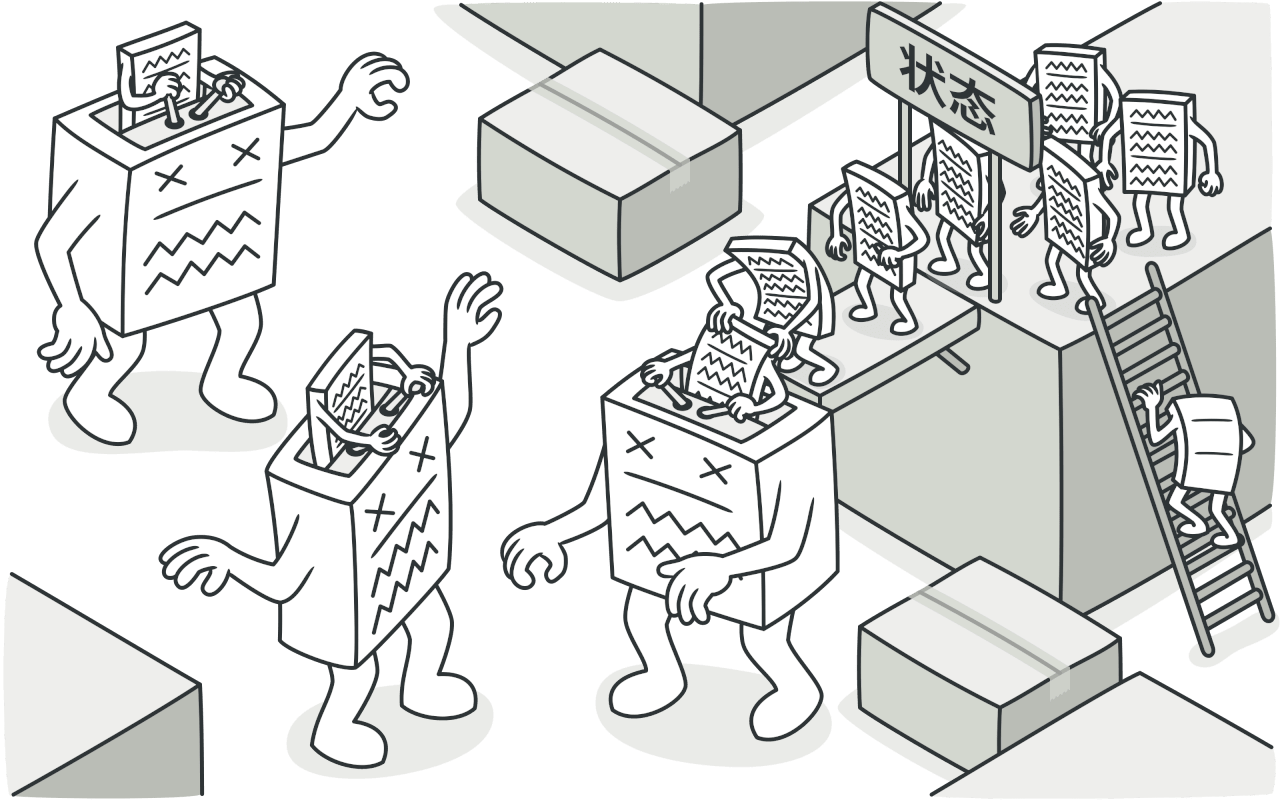设计模式-状态
hexiaopi 5/4/2023 Go行为型模式

# 什么是状态模式
状态模式(State Pattern) 允许对象在其内部状态发生变化时改变其行为。通过将状态转换代码从主逻辑中抽离并封装在状态对象中,使得对象能够在行为上进行更灵活的变化。
# 包含哪些角色

Context: 上下文
它是包含状态的主对象。它还包含一些用于在状态之间切换的方法。
State: 状态
它定义一个接口,用于封装与上下文的特定状态相关的行为。
ConcreteStates: 具体状态类
实现State接口,每个具体状态都提供各自的实现方式。
# 代码示例
package state
import "fmt"
type Context struct {
state State
}
func (c *Context) ChangeState(state State) {
c.state = state
}
func (c *Context) Start() {
c.state.Start(c)
}
func (c *Context) Stop() {
c.state.Stop(c)
}
func (c *Context) Run() {
c.state.Run(c)
}
type State interface {
Start(ctx *Context)
Stop(ctx *Context)
Run(ctx *Context)
}
type StartState struct {
}
func (s *StartState) Start(ctx *Context) {
fmt.Println("already start")
}
func (s *StartState) Stop(ctx *Context) {
fmt.Println("change start state to stop")
ctx.ChangeState(&StopState{})
}
func (s *StartState) Run(ctx *Context) {
fmt.Println("change start state to run")
ctx.ChangeState(&RunState{})
}
type StopState struct {
}
func (s *StopState) Start(ctx *Context) {
fmt.Println("change stop state to start")
ctx.ChangeState(&StartState{})
}
func (s *StopState) Stop(ctx *Context) {
fmt.Println("already stop")
}
func (s *StopState) Run(ctx *Context) {
fmt.Println("can't change stop state to run")
}
type RunState struct {
}
func (s *RunState) Start(ctx *Context) {
fmt.Println("can't change run state to start")
}
func (s *RunState) Stop(ctx *Context) {
fmt.Println("change run state to stop")
ctx.ChangeState(&StopState{})
}
func (s *RunState) Run(ctx *Context) {
fmt.Println("already run")
}
1
2
3
4
5
6
7
8
9
10
11
12
13
14
15
16
17
18
19
20
21
22
23
24
25
26
27
28
29
30
31
32
33
34
35
36
37
38
39
40
41
42
43
44
45
46
47
48
49
50
51
52
53
54
55
56
57
58
59
60
61
62
63
64
65
66
67
68
69
70
71
72
73
74
75
76
77
78
2
3
4
5
6
7
8
9
10
11
12
13
14
15
16
17
18
19
20
21
22
23
24
25
26
27
28
29
30
31
32
33
34
35
36
37
38
39
40
41
42
43
44
45
46
47
48
49
50
51
52
53
54
55
56
57
58
59
60
61
62
63
64
65
66
67
68
69
70
71
72
73
74
75
76
77
78
使用示例
package state
func ExampleState() {
start := &StartState{}
context := Context{state: start}
context.Start()
context.Run()
context.Stop()
context.Run()
// Output:
// already start
// change start state to run
// change run state to stop
// can't change stop state to run
}
1
2
3
4
5
6
7
8
9
10
11
12
13
14
15
2
3
4
5
6
7
8
9
10
11
12
13
14
15
# 总结
# 优点
- 将状态抽象成对象,使得状态之间的转换更加清晰明了。通过将每种状态封装成具体的类,可以使代码更加简单易懂,避免了状态转换时大量的条件判断。
- 状态之间的转换变得容易扩展。由于状态之间的转换是由状态对象自身完成的,因此只需要增加、修改或删除对应的状态类即可扩展或修改状态转换,而不影响其他部分。
- 提高代码的复用性和灵活性。由于每个状态都是一个独立的对象,因此可以在不同的上下文中重复使用。这样,就可以实现更多的组合方式,从而提高代码的复用性和灵活性。
# 缺点
对于简单的状态机,引入状态模式会增加额外的复杂度。如果状态机只有几个状态,那么引入状态模式可能会让代码更加复杂,难以维护。
增加了系统的类和对象数量。引入状态模式会增加额外的类和对象,在一定程度上增加了系统的复杂度和开销。

